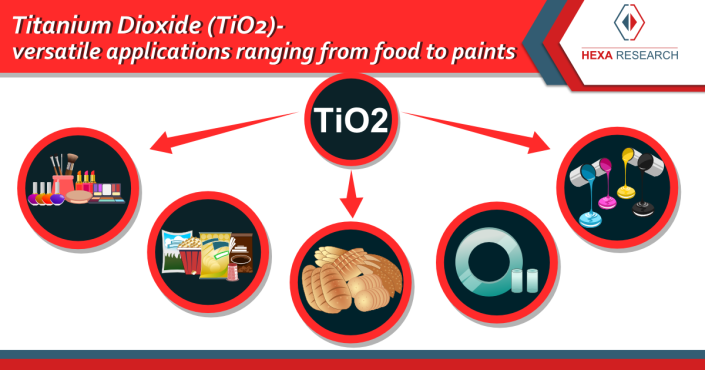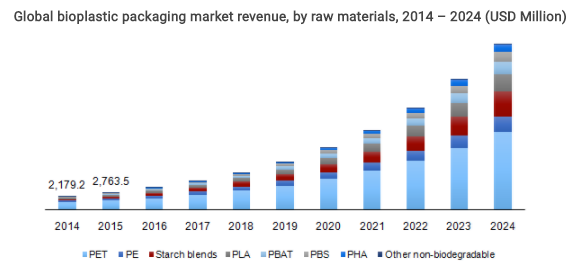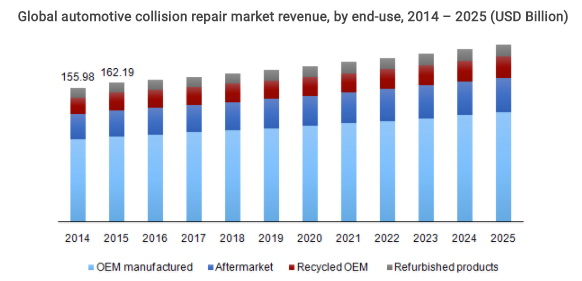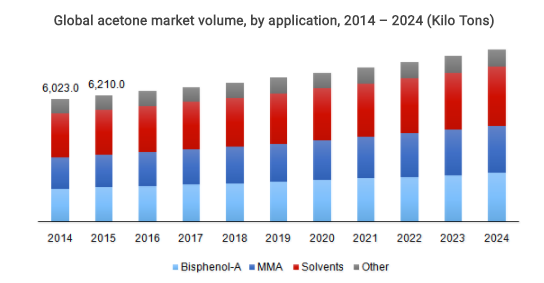Titanium Dioxide (TiO2) Market Size, Share | Industry Report, 2024
The global titanium dioxide market is expected to reach USD 27.49 billion by 2024 owing to the increasing demand of titanium dioxide in paper, paint & coating, cosmetics, and plastic industries. In 2014, DuPont Titanium Technologies started a manufacturing facility in Alamira, Mexico having a capacity of 200,000 tons/year which will help in fulfilling the demand worldwide.

Rising demand for lightweight automobiles is expected to play a vital role in the growth of global titanium dioxide market. Materials such as polycarbonates are used in the manufacturing of lightweight automotive which have low scratch resistance value. Also, the product is used in various industries such as chemical intermediates, fiber, technical titanium, inks for printer and rubber.
Access full report at https://www.hexaresearch.com/research-report/titanium-dioxide-industry
Keeping these driving factors in mind, companies are ramping up their production capacity. In 2015, PPG International entered into a partnership agreement with Henan Billions Chemicals Co. LTD. to set up a new manufacturing unit for titanium dioxide which is expected to produce 100,000 metric tons per year to expand its footprint in Asia Pacific. Companies such as Argex Titanium are using unique patented CTL process which involves low-cost feedstock material and solvent extraction method to produce a high-quality product.
Also, companies are focusing on increasing the applications of titanium dioxide int water treatment using techniques such as photocatalysis, in which titanium dioxide is used to speed up the solar disinfection process.
In 2016, paint & coating segment contributed 57.4% in terms of revenue. It was also extensively used in the plastics industry, paper industry, inks, and other specialty segments. The growth of these sectors is expected to boost the market positively over the next few years.

The plastic industry was the second largest segment due to the increasing applications as an excellent thermal stabilizer. In 2016 plastics segment contributed 23.2% in terms of revenue and is expected to grow with a positive CAGR during the forecast period.
Paper industry is the third largest user of titanium dioxide and contributed 10.4% in terms of revenue globally. Titanium dioxide is used in the manufacturing of decorative papers, these are used in the manufacturing of flooring, furniture, and wallpapers. Demand for high-end furniture is increasing which is expected to boost the demand for titanium dioxide. The paper industry is expected to contribute about 10.4% during the forecast period.
The global titanium dioxide market is expected to grow at a very lucrative rate due to its use in various above-mentioned industries. Also, titanium dioxide is used as a substitute for talc and kaolin which in turn is expected to boost the market for titanium dioxide.
Request for a free sample at https://www.hexaresearch.com/research-report/titanium-dioxide-industry/request-sample
Global Acetone Market Size Expected To Reach $22.10 Billion By 2024 | Hexa Research
Bioplastics Market By Types, Application & Forecast 2024 | Hexa Research
The global bioplastic packaging market to reach USD 34.24 billion by 2024, driven by the rising consumer demand for resource efficient and eco-friendly products. Europe was the largest market accounting for 32.7% of the volume share in 2016 due to supporting regulations coupled with consumer awareness regarding the conservation of the environment. North America and Asia-Pacific followed suit, where the regions together are expected to contribute USD 3.26 billion by 2024.

Keeping these driving factors in mind, companies are ramping up their production capacity as well as foraying into R&D of application of new biopolymers into mainstream applications. For instance, in October 2016, BASF and Avantium entered into a joint venture to form Synvina JV, which will manufacture and market FDCA and PEF. Synvina JV has a production capacity of 50,000 metric tons per year for FDCA and PEF.
Moreover, companies are focusing on R&D to expand the utilization of different raw materials such as PBS, PLA, and PBAT in various mainstream packaging applications. For instance, in April 2017, UK-based Biome Bioplastics developed a fully compostable and recyclable coffee cup made entirely from bioplastic materials. These factors together are expected to provide an impetus to the growth of the bioplastic packaging market over the next seven years.
PET dominated the global market contributing to USD 1.84 billion in 2016. The polymer was extensively used in rigid packaging on account of its high durability, transparency, and ease of moldability. Initiatives undertaken by companies such as Coca-Cola, P&G, and Heinz to use bio-based materials for packing beverages, sauces & spreads and cosmetics is expected to bolster the growth of the rigid packaging market.
Access full report or request for free sample at: https://www.hexaresearch.com/research-report/bioplastic-packaging-market
Increasing demand for flexible packaging solutions on account of several benefits including size and weight particularly in food applications coupled with rising demand for biodegradable films is anticipated to boost the growth of the market. The segment is expected to grow at a volume CAGR of 20.6% from 2017 to 2024.
Food packaging accounted for 9% of the overall market share in 2016 and is likely to witness above average growth as a result of rising consumer requirement for eco-friendly packaging. Aesthetic attributes such as transparency, size, weight, and presentation are expected to drive the growth of the segment over the projected period.
The growth of the global bioplastic packaging industry driven primarily by consumer demand is also likely to be favored by the implementation of stringent regulations for its synthetic counterparts. Despite the fall in crude oil prices, companies such as BASF, Arkema Dow, Solvay, and Braskem are continuing production at their facilities and focusing on R&D. These factors are likely to result in a tremendous growth of the global bioplastic packaging market growing at a revenue CAGR of 28.3% over the next seven years.
Global Automotive Collision Repair Market worth USD 206.46 Billion By 2025 | Hexa Research
The global automotive collision repair market to reach USD 206.46 billion by 2025, driven by a surge in automobile production, digitalization of automobile repair services and advances in manufacturing technology such as 3D printing of automotive parts to optimize costs. Europe was the largest market accounting for 44.9% of the revenue share in 2016. However, it is expected to lose its share over the forecast period on account of increase in trade barriers created by Brexit.

The increase in demand for vehicles driven by improvement in lifestyle in developing countries such as India and Brazil is expected to drive the growth of the market. Asia Pacific is anticipated to witness the fastest growth over the forecast period at a CAGR of 3.7% on account of increase in production and sale of automobiles and rising living standard. The increase in the number of vehicles on the road in countries such as China and India is expected to drive growth.
The automobile industry is expected to grow on account of increasing demand for passenger cars. Increasing number of accidents due to the lack of proper infrastructure is projected to drive the demand for spare parts and other special tools. The collision repair market is expected to grow at a CAGR of 2.5% from 2017 to 2025. The requirement of quick turnaround time for replacement of parts is likely to be an opportunity for growth of the market.
Companies are investing extensively in R&D to enhance technology. For instance, in July 2016, BASF announced plans to step up its R&D activities for automotive coatings to a new world-class platform at the BASF Innovation Campus Asia Pacific in Shanghai, China.
In addition to this companies are adopting the strategy of merger & acquisition. In February 2016, 3M Automotive Aftermarket Division collaborated with the German-based Tool Technic Systems AG & Co. KG to provide the collision repair industry a comprehensive surface preparation and finishing system. The new system is expected to launch in US and Canada impacting the growth of the market in North America.
In September 2016, BASF acquired Guangdong Yinfan Chemistry, China. This acquisition resulted in an addition of Yinfan’s products to BASF’s portfolio and enabled BASF to expand its portfolio in Asia Pacific.
Discover key insight on Automotive Collision Repair Industry – https://www.hexaresearch.com/research-report/automotive-collision-repair-industry
Ceramic Filters Market Size, Share, Industry Trends, Report – 2016 To 2024

Global ceramic filters market was valued near to USD 900 million in 2015. It is projected to grow at a CAGR of 13% from 2016 to 2024 (forecast period). This can be attributed to rising emphasis on environmental protection. Environmental agencies such as the EPA (Environmental Protection Agency), EEA (Energy & Environment Affairs), NSF (National Science Foundation), etc. have implemented various mandates pertaining to air emissions as well as water treatment/disposal. This would trigger demand for ceramic filters in the coming years.
Ceramic filters possess properties like chemical inertness, low operational costs, and extended life. They are well-suited for multiple applications across major end-users. However, they require huge capital investments. This, coupled with price volatility could hinder market growth.
For Market Research Report on “Ceramic Filters Market” Visit – https://www.hexaresearch.com/research-report/ceramic-filters-market
The global ceramics filters market is segmented into products, applications, and regions. Products are split into water filters and air filters. Ceramic water filters, with about 56% revenues, dominated in 2015. This is credited to directives that encourage industries to choose eco-friendly water treatment and water disposal processes.
Air filters are estimated to grow at the highest rate (CAGR of 13%), during the forecast period. Applications consist of commercial, residential, & industrial. Industrial is further divided into bio-filtration, oil/water separation, hot gas filtration, and others.
In 2015, ceramic filters were maximally used in residential applications. Residences contributed over 40% to the market revenues that year. Accelerated industrialization in emergent countries like Indonesia, India, and China could boost industrial applications. This segment should grow the fastest (13% CAGR) till 2024.
Regional segments encompass North America, Europe, Asia-Pacific, Middle East & Africa (MEA), and Central & South America (CSA). Asia Pacific garnered highest earnings in 2015. Escalating need for potable water and rising focus on safeguarding the environment are the main regional drivers. MEA is likely to grow substantially (15.6%) in the seven years ahead. Petrochemical industries in Qatar and Saudi Arabia generate most of the regional demand.
The worldwide ceramic filters market is greatly fragmented. Leading market players are Ceramic Filters Company Inc., Doulton Ceramics, Anguil Environmental Systems Inc., and Unifrax I LLC. Research & development, and partnerships are the main strategies for expanding manufacturing capacity and product portfolio.
Global Organic Personal Care Market to reach $15.8 billion by 2024
The worldwide organic personal care market generated over USD 8.3 billion in 2014. It is anticipated to grow at around 9 percent CAGR during 2016 to 2024 (forecast period). The market will produce sales worth USD 15.8 billion by 2024. This significant expansion may be ascribed to awareness regarding eco-friendly products that do not have petrochemicals, parabens, and aluminum salts.
Novel organic products have grown. In addition, manufacturers & sellers consider innovative means of ‘demand generation.’ Both these factors can drive market demand in the near future. Organic products are made from plant roots, essential oils, herbs, & flowers coupled with naturally available emulsifiers, humectants, additives, & surfactants.
For Market Research Report on “Organic Personal Care Market” Visit – https://www.hexaresearch.com/research-report/organic-personal-care-industry
This market has greatly evolved across the globe. Sales training for ‘consumer education’ regarding superior ‘beauty products’ should propel market revenues. Client awareness about personal health is also likely to add market growth till 2024. Enhanced living standards and increased disposable earnings of the employed ‘middle-class’ populace across developing Asian Pacific nations may propel the market in the forecast period.
However, discrepancies in ‘feedstock supply’ would hinder the market. Technological advancements and research & developments in processing & cost-efficient manufacturing were the key drivers of organic personal care market in the recent years. Research on developing customized & sophisticated products can open market prospects.
Products and geographies split the market. Products comprise skin care, hair care, oral care, and others. Skin care led in terms of demand and surpassed USD 2.5 billion in 2013. Hair is estimated to grow at nearly 9.8 percent CAGR during 2014 to 2020. Oral care captured 13 percent shares in 2013 and should undergo high growth. Its shares could be attributed to escalating gum diseases.
The geographies are Asia Pacific, North America, Europe, and rest of the world. North America reigned in the recent past and has regional prospects in Mexico. Europe and Asia Pacific followed North America and were pushed by customer inclination and advanced products. The worldwide organic personal care market is mainly characterized by product innovations.
Some of its players are L’Oreal; The Body Shop; Aveda Corp.; and Amway. Few companies have introduced ayurvedic substances; like clove, tulsi, lemon, neem, etc.
Global Integrated Systems Market to exit exponential CAGR till 2024 – Hexa Research
The global integrated systems market is projected to exhibit double-digit growth during the forecast period (2016-2024). This may be attributed to substantial demand for abridged deployments and lower number of standalone solutions. The shift from mainframe systems to Internet computing has altered the way consumers buy, build and deliver technology.
Integrated systems are easily managed through a single console leading to lesser operational expenditure. They simplify processes, reduce costs, and are highly flexible. These advantages along with the escalating need to reexamine data center infrastructure are fuelling market growth.
For Market Research Report on “Integrated Systems Market” Visit – https://www.hexaresearch.com/research-report/integrated-systems-market/
However, high deployment costs are a major challenge to widespread adoption of such systems in the coming years.
The integrated system’s market is segmented based on services, end-users, products, and regions.
Services are divided into consulting, maintenance & support, and integration & installation. Integration & installation are likely to grow at a lucrative pace till 2024. This owes to huge demand from several small, medium and large enterprises. End-users comprise defense & energy, manufacturing, healthcare, retail, educational institutes, information technology & telecommunication systems, and BFSI (Banking, Financial Services, & Insurance).
Retail and manufacturing are estimated to experience robust growth in the eight years ahead. The retail sector benefits from in-store supervision of complete systems, which reduces store system downtime. Such proactive management lowers ownership costs. Revenues from BFSI could exceed USD 8.5 billion by 2024. Information technology & telecommunication systems are also foreseen to garner high revenues in forthcoming years.
Products consist of pre-integrated systems, tested systems, and validated systems. Validated systems are further split into integrated workload systems and integrated infrastructure systems. The latter is expected to dominate the market in the forecast period.
North America, Europe, Latin America, Asia-Pacific, and MEA (the Middle East & Africa) constitute the regional market segments. North America reigns as a result of high market penetration and latest technological deployments. Asia-Pacific could be a key contributor to the global revenues. This would be triggered by data center transformations in the emergent economies of China and India.
Leading players in the worldwide integrated systems market encompass Cisco Systems Inc., Hewlett & Packard (HP) Company, Oracle Corporation, IBM Inc., and Fujitsu Inc. Many companies ally with those offering cloud-based storage and virtualization solutions for expanding their converged infrastructure installation.
Aerospace Plastics Market To Grow At CAGR Above 10% Till 2024
The global aerospace plastics market stood nearly 57 kilotons in 2014. It is estimated to grow at over 10 percent CAGR from 2016 to 2024 (forecast period). Regulatory policies coupled with robust fiscal aid should be the key market propeller. The market will also be driven by usage in airplanes, alternatives for steel & aluminium, and expansion in the aviation industry.
The aviation industry is likely to observe high growth across Middle Eastern nations; like Qatar, U.A.E., and Saudi Arabia. Higher air traffic in defense & commercial sectors has contributed sales for the North American market. Strict policies on petrol-based products can hamper feed stock (high-grade plastics, etc.) availability.
For Market Research Report on “Aerospace Plastics Market” Visit – https://www.hexaresearch.com/research-report/aerospace-plastics-industry/
Moreover, adoption of carbon fibers in other applications may limit the availability of raw materials. Airplane manufacturers have begun employing a blend of thermoplastic & metal composites to lower fuel emissions and ensure passenger convenience. The aerospace plastics market is fragmented by applications, polymers, end-users, and geographies.
Applications comprise wings & rotor blades, air-frame & fuselage, and cabin areas. Air-frame & fuselage was the biggest segment in 2013. Demand for aerospace plastics in wings & rotor blades surpassed 7, 900 tons in 2014. ‘Plastics adoption’ in wings makes the latter quite resistant to metal fatigue. Demand for cabin area applications would grow at over 5 percent CAGR till 2024.
Polymers are polyether ketone ketone (PEKK), polyether ether ketone (PEEK), and polymethyl methacrylate (PMMA). PEKK was nearly USD 74.5 million in 2014. It has high ‘glass transition temperature’ & ‘mechanical load.’ PMMA generated around USD 168 million in 2014. It is used in flight decks & cockpits owing to its lightweight features.
Aerospace plastics do not rust and can function better than other materials. This characteristic bodes well for the aerospace plastics market and drives its incomes. End-users consist of military aircraft, general aviation, and commercial & freighter aircraft. Commercial & freighter was the biggest segment in 2013. Military aircraft are likely to experience the fastest growth.
Geographical regions encompass Europe, Asia Pacific, North America, and rest of the world. Europe dominated the global market in 2013. This region and Asia Pacific may be lucrative in the near future.
Automotive Electronics Market To Reach Beyond $290 Billion By 2024
The global automotive electronics market is estimated to be valued more than USD 290 billion by 2024. Rising premium audio system and advanced driver assistance system demands are the key factors anticipated to augment the market growth. Accident recorder systems, emergency call systems, and alcohol ignition interlocks are the technologies that are said to boost the growth in the near future. In addition, rising trend of in-vehicle infotainment is also likely to help boost the market. High complexity levels and lacking awareness about the overall subsystems’ understanding may hinder the growth. The global automotive electronics market is divided into applications and regions.
The application sector comprises body electronics, Advanced Driver Assistance System (ADAS), infotainment, safety systems, and powertrain. The regulatory boards of various economies have taken steps for integrating safety gadgets in cars and other vehicles so as to restrain the occurrence of fatalities caused by road accidents.
For Market Research Report on “Automotive Electronics Market” Visit – https://www.hexaresearch.com/research-report/automotive-electronics-industry
Some of the necessary devices utilized to ensure passenger safety are backup sensing system, airbags, on and off switches for air bags, auto dimming mirrors or electrochromic mirror, head restraints, energy-absorbing steering system, heads-up display, passenger sensing system, and padded knee bolster.
The ADAS application sector is projected to witness high growth during the forecast period (from 2016 to 2024). This is due to various strict safety regulations resulting in the major adoption of in-car active safety systems. Demands for in-vehicle data storage, to support sophisticated in-car features, are estimated to be the major growth driving factors for infotainment systems.
Geographically, North America dominated the global automotive electronics market in 2015. However, Asia-Pacific is anticipated to experience high growth on account of the rising needs to meet strict standards, to increase product quality, for reduced production costs, and for customized vehicle features. Developing economies including India and China are likely to positively impact the growth of the region.
The major companies operating in the global automotive electronics market include Robert Bosch GmbH; Continental AG; Denso Corp.; Delphi Automotive PLC.; TRW Automotive; Johnson Controls Inc.; and Autoliv AB. The major sustainability and growth strategies used by all such companies include creating technology partnerships with other companies in the ecosystem. Plus, automakers are anticipated to increase the intelligent electronics adoption that makes their products safe to drive and environment-friendly.
